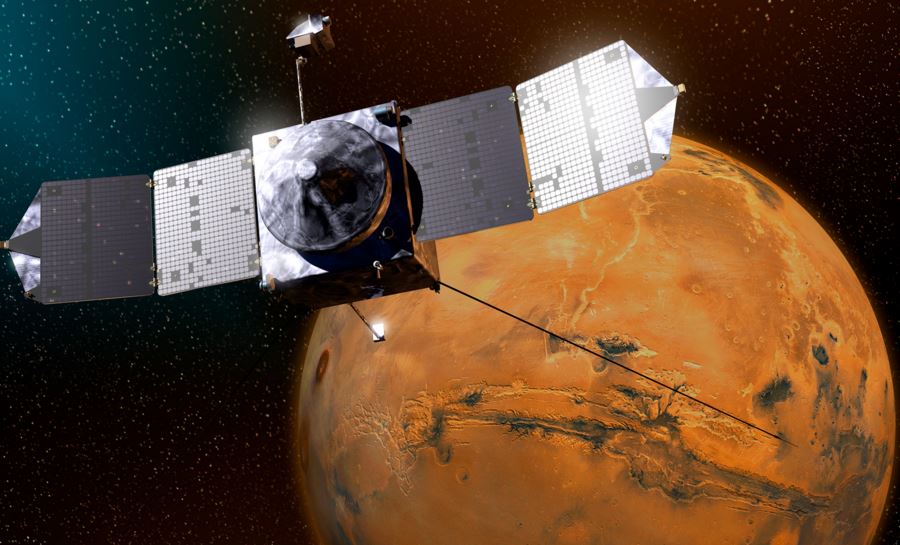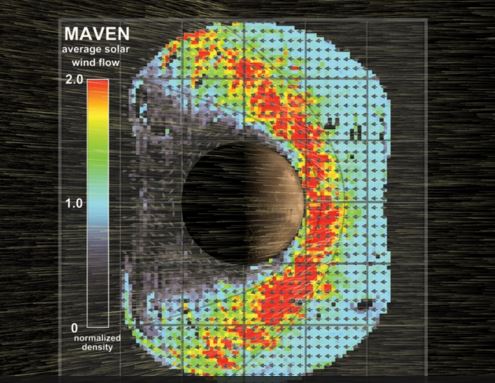Solar wind stripped Mars of its once thick atmosphere, according to NASA’s Mars Atmosphere and Volatile Evolution (MAVEN) mission. The Red Planet, which once was warm and wet – an environment that may have supported life as we know it – is today a cold and arid world.
MAVEN data has enabled scientists to calculate how rapidly Mars’ current atmosphere is being stripped away into space by the solar wind.
Solar wind is the continuous flow of charged particles, mainly electrons and protons, that comes from the Sun and permeates the solar system. These particles travel at approximately one million miles per hours.
 An artist’s rendering of a solar storm striking Mars and stripping ions from the planet’s upper atmosphere. If the Red Planet had a global magnetic field, like Earth does, its atmosphere would not have disappeared into space. (Image: mars.nasa.gov)
An artist’s rendering of a solar storm striking Mars and stripping ions from the planet’s upper atmosphere. If the Red Planet had a global magnetic field, like Earth does, its atmosphere would not have disappeared into space. (Image: mars.nasa.gov)
Ions shot into space
The solar wind carries a magnetic field. As it flows past Mars it can generate an electric field, which accelerates electrically-charged atoms (ions) in the upper atmosphere, and shoots them into space.
Unlike Earth, Mars does not have a global magnetic field to deflect the continuous stream of charged particles that blow off the Sun.
The data showed that during solar storms, Mars’ atmosphere erodes at a much faster pace. The researchers published their findings in the peer-reviewed, academic journal Geophysical Research Letters, and also in Science.
Astronaut, John Grunsfeld, associate administrator for the NASA Science Mission Directorate in Washington, said:
“Mars appears to have had a thick atmosphere warm enough to support liquid water which is a key ingredient and medium for life as we currently know it. Understanding what happened to the Mars atmosphere will inform our knowledge of the dynamics and evolution of any planetary atmosphere.”
“Learning what can cause changes to a planet’s environment from one that could host microbes at the surface to one that doesn’t is important to know, and is a key question that is being addressed in NASA’s journey to Mars.”
 NASA’s Mars Atmosphere and Volatile EvolutioN (MAVEN) spacecraft has been in orbit around Mars since September 2014. (Image: www.nasa.gov)
NASA’s Mars Atmosphere and Volatile EvolutioN (MAVEN) spacecraft has been in orbit around Mars since September 2014. (Image: www.nasa.gov)
According to MAVEN measurements, solar wind is stripping away gas at a rate of approximately 100 grams (about 1/4 of a pound) each second.
Gas loss greater in the past
Bruce Jakosky, MAVEN principal investigator at the University of Colorado, Boulder, said:
“Like the theft of a few coins from a cash register every day, the loss becomes significant over time. We’ve seen that the atmospheric erosion increases significantly during solar storms, so we think the loss rate was much higher billions of years ago when the sun was young and more active.”
A series of powerful solar storms struck Mars’ atmosphere in March 2015. According to MAVEN data, gas was ‘shot’ into space at a much faster rate during that time.
The authors believe that the combination of faster loss rates and more frequent solar storms in the past, that sent much of the atmosphere into space, dramatically changed the Martian climate.
MAVEN has been monitoring solar wind and ultraviolet light, in order to find out how they strip gas from the top of the Red Planet’s atmosphere.
 If Mars had not lost most of its atmosphere, what would it have looked like today? It would have been warm, humid and wet – with perhaps abundant life.
If Mars had not lost most of its atmosphere, what would it have looked like today? It would have been warm, humid and wet – with perhaps abundant life.
Atmosphere lost in three regions
The latest results suggest that the loss occurs in three different regions of Mars:
1. Down the ‘tail’, where the solar wind flows behind the planet.
2. Above the north and south poles of Mars, in a ‘polar plume’.
3. “From an extended cloud of gas surrounding Mars.”
The researchers determined that nearly 75% of the escaping ions come from the tail region, almost 25% from the plume region, and a tiny proportion from the extended cloud.
Mars once had lots of liquid water
Some regions of Mars have evidence suggesting there was once abundant water. There are features in Mars’ ancient regions resembling valleys which were carved by rivers and mineral deposits that could only have formed in the presence of liquid water.
These features have led researchers to believe that some billions of years ago, Mars’ atmosphere was much warmer and denser than it is today. They think the Red Planet had rivers, lakes, and maybe even oceans of liquid water.
Earlier this year, scientists using NASA’s Mars Reconnaissance Orbiter detected the seasonal appearance of hydrated salts, suggesting there is briny liquid water on Mars.
Sadly, Mars’ current atmosphere is far too thin and cold to support long-lasting or large amounts of liquid water on the planet’s surface.
MAVEN project scientist from NASA’s Goddard Space Flight Center in Greenbelt, Maryland, Joe Grebowsky, said:
“Solar-wind erosion is an important mechanism for atmospheric loss, and was important enough to account for significant change in the Martian climate. MAVEN also is studying other loss processes — such as loss due to impact of ions or escape of hydrogen atoms — and these will only increase the importance of atmospheric escape.”
The MAVEN mission, which was launched in November 2013, aims to determine how much of Mars’ atmosphere and water have ended up in space.
Video – Solar wind stripping Marian atmosphere
Mars is a cold and arid desert today, but researchers think that billions of years ago it was warm and wet. The loss of the early Martian atmosphere may have led to this dramatic change, and one of the prime suspects is the solar wind.

